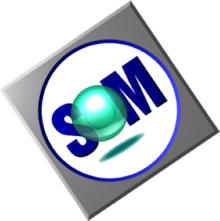IBM System Object Model
 |
|
| Developer(s) | IBM |
|---|---|
| Stable release |
3.0 / December 1996
|
| Operating system | OS/2, Windows, AIX, Classic Mac OS, Copland, OS/390, NonStop OS |
| Type | object-oriented shared library system |
In computing, the System Object Model (SOM) is an object-oriented shared library system developed by IBM. DSOM, a distributed version based on CORBA, allowed objects on different computers to communicate.
SOM defines an interface between programs, or between libraries and programs, so that an object's interface is separated from its implementation. SOM allows classes of objects to be defined in one programming language and used in another, and it allows libraries of such classes to be updated without requiring client code to be recompiled.
A SOM library consists of a set of classes, methods, static functions, and data members. Programs that use a SOM library can create objects of the types defined in the library, use the methods defined for an object type, and derive subclasses from SOM classes, even if the language of the program accessing the SOM library does not support class typing. A SOM library and the programs that use objects and methods of that library need not be written in the same programming language. SOM also minimizes the impact of revisions to libraries. If a SOM library is changed to add new classes or methods, or to change the internal implementation of classes or methods, one can still run a program that uses that library without recompiling. This is not the case for all other C++ libraries, which in some cases require recompiling all programs that use them whenever the libraries are changed, known as the fragile binary interface problem.
SOM provides an application programming interface (API) that gives programs access to information about a SOM class or SOM object. Any SOM class inherits a set of virtual methods that can be used, for example, to find the class name of an object, or to determine whether a given method is available for an object.
SOM was intended to be used universally from IBM's mainframe computers right down to the desktop in OS/2, allowing programs to be written that would run on the desktop but use mainframes for processing and data storage. IBM produced versions of SOM/DSOM for OS/2, Microsoft Windows and various Unix flavours (notably IBM's own AIX). For some time after the formation of the AIM alliance, SOM/DSOM was also used by Apple Computer for similar purposes. It was most widely used in their OpenDoc framework, but saw limited use in other roles as well.
...
Wikipedia
